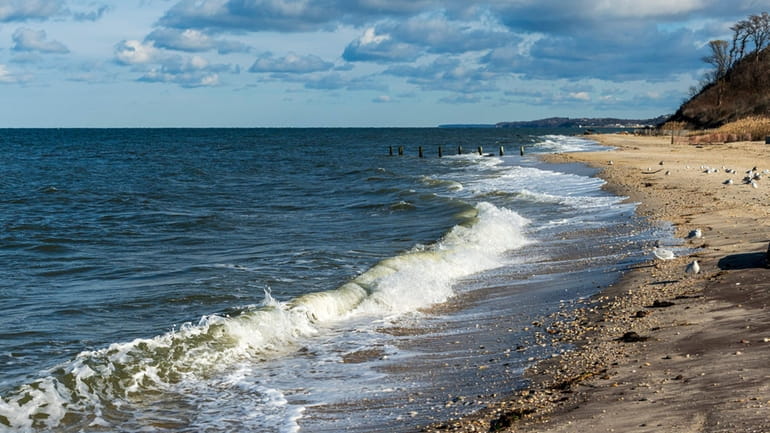Long Island Sound watershed projects get $12M in grants

Iron Pier Beach on Long Island Sound in Riverhead Town, on Wednesday. Credit: Tom Lambui
Thirty-nine grants totaling $12 million have been awarded to nonprofit organizations and a municipality working to improve the ecological health of Long Island Sound, federal officials announced Monday.
Grants will go to groups from Connecticut, Massachusetts, Vermont and New Hampshire as well as New York — all in the Long Island Sound watershed, which extends across 16,820 square miles. The ecosystem provides habitat to more than 1,200 species of invertebrates, 170 species of fish, dozens of migratory birds, as well as harbor seals, dolphins and whales.
The grants are funded by the National Fish and Wildlife Foundation’s Long Island Sound Futures Fund, in partnership with the Environmental Protection Agency, the Long Island Sound Study and the National Fish and Wildlife Service.
The 39 projects address a range of problems threatening the Sound, including nitrogen pollution, “ghost” lobster traps, eroding shorelines and endangered shorebirds. They will result in “cleaner water, healthier watersheds, thriving habitats, and more abundant wildlife,” Lisa Garcia, regional administrator for EPA Region 2, said during a virtual announcement of the grants.
Seven of the 39 grants this year will be directed to projects on Long Island.
The Citizens Campaign for the Environment, with offices in Farmingdale, will receive $181,000 to build two rain gardens in the Village of Northport. “It’s an ideal location for a rain garden,” said Adrienne Esposito, director of the CCE. The gardens will capture stormwater that now flows into Northport harbor, and will reduce by 50% the nitrogen, phosphorus, and fecal coliform that flow with it, Esposito said.
The group has already built three rain gardens in Northport under a previous grant, with input from community members, and the new gardens will most likely also feature hardy natives that attract pollinators.
Cornell Cooperative Extension of Suffolk County was awarded $386,000 to remove thousands of abandoned lobster traps in the Sound. Cornell has removed about 21,000 of these derelict traps over the past 12 years with the help of commercial lobstermen, who know where in the 1,300 square miles of open water to find them.
These “ghost traps” are often still functional but “no one is tending to them,” which leads fish and crustaceans to swim inside and die, said Scott Curatolo-Wagemann, fisheries director of the marine program at CCE. “When we pick up traps, about a third of them have an organism in them,” he said.
The new grant will fund a sonar system to help them identify “areas of high concentration,” Curatolo-Wagemann said.
Stony Brook University received $477,200 to restore oyster beds in Oyster Bay and Cold Spring Harbor.
Cornell Cooperative Extension of Nassau County received $250,000 to develop a volunteer-driven oyster reef program and education campaign.
ReWild Long Island will use its $230,300 grant to plant native gardens and to continue its summer program, which offers stipends to high school students who grow organic produce for local food pantries.
The National Audubon Society was awarded $70,600 for its “Share the Shore” project to protect shore birds like the piping plover and American oystercatcher, which nest on busy Long Island and Connecticut beaches.
The Town of Brookhaven received $70,000 to remove invasive plants at West Meadow Beach in Stony Brook.
Other programs across the Sound’s watershed will address water quality through improved manure management on Connecticut dairy and livestock farms, and through updated stormwater and sewage infrastructure; funds are also aimed at dam removal and shoreline resilience.
A priority this year was to fund projects in underserved communities. Grants to organizations in the Bronx, Queens and Connecticut will go toward environmental education programs and green schoolyards, which prevent stormwater runoff as well as provide recreation space for students and the surrounding communities.
Last year, $10 million was awarded through the Futures Fund, which has provided $56 million for 640 projects since it was established in 2005. Recipients have pitched in an additional $65 million in matching funds, for a total of $121 million.
